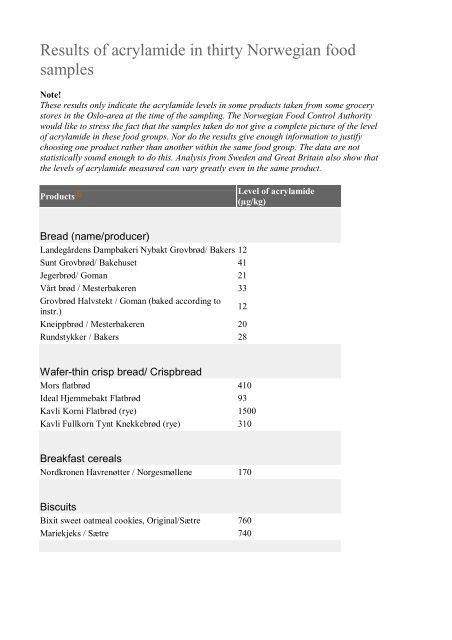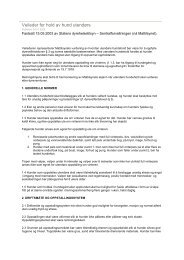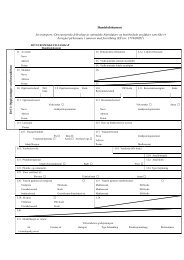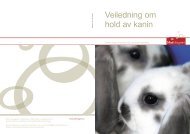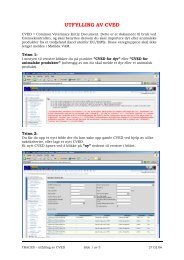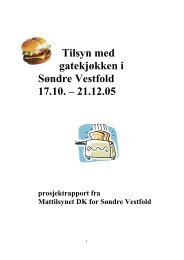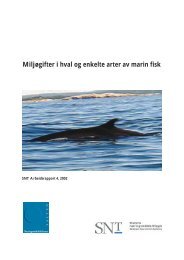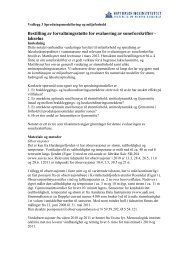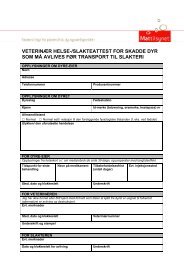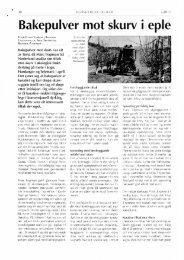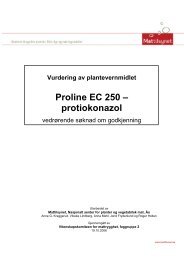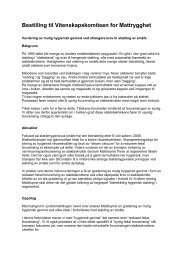Results of acrylamide in thirty Norwegian food samples - Mattilsynet
Results of acrylamide in thirty Norwegian food samples - Mattilsynet
Results of acrylamide in thirty Norwegian food samples - Mattilsynet
You also want an ePaper? Increase the reach of your titles
YUMPU automatically turns print PDFs into web optimized ePapers that Google loves.
<strong>Results</strong> <strong>of</strong> <strong>acrylamide</strong> <strong>in</strong> <strong>thirty</strong> <strong>Norwegian</strong> <strong>food</strong><br />
<strong>samples</strong><br />
Note!<br />
These results only <strong>in</strong>dicate the <strong>acrylamide</strong> levels <strong>in</strong> some products taken from some grocery<br />
stores <strong>in</strong> the Oslo-area at the time <strong>of</strong> the sampl<strong>in</strong>g. The <strong>Norwegian</strong> Food Control Authority<br />
would like to stress the fact that the <strong>samples</strong> taken do not give a complete picture <strong>of</strong> the level<br />
<strong>of</strong> <strong>acrylamide</strong> <strong>in</strong> these <strong>food</strong> groups. Nor do the results give enough <strong>in</strong>formation to justify<br />
choos<strong>in</strong>g one product rather than another with<strong>in</strong> the same <strong>food</strong> group. The data are not<br />
statistically sound enough to do this. Analysis from Sweden and Great Brita<strong>in</strong> also show that<br />
the levels <strong>of</strong> <strong>acrylamide</strong> measured can vary greatly even <strong>in</strong> the same product.<br />
Products (1)<br />
Bread (name/producer)<br />
Landegårdens Dampbakeri Nybakt Grovbrød/ Bakers 12<br />
Sunt Grovbrød/ Bakehuset 41<br />
Jegerbrød/ Goman 21<br />
Vårt brød / Mesterbakeren 33<br />
Grovbrød Halvstekt / Goman (baked accord<strong>in</strong>g to<br />
<strong>in</strong>str.)<br />
12<br />
Kneippbrød / Mesterbakeren 20<br />
Rundstykker / Bakers 28<br />
Wafer-th<strong>in</strong> crisp bread/ Crispbread<br />
Mors flatbrød 410<br />
Ideal Hjemmebakt Flatbrød 93<br />
Kavli Korni Flatbrød (rye) 1500<br />
Kavli Fullkorn Tynt Knekkebrød (rye) 310<br />
Breakfast cereals<br />
Nordkronen Havrenøtter / Norgesmøllene 170<br />
Biscuits<br />
Bixit sweet oatmeal cookies, Orig<strong>in</strong>al/Sætre 760<br />
Mariekjeks / Sætre 740<br />
Level <strong>of</strong> <strong>acrylamide</strong><br />
(µg/kg)
Potato cakes<br />
Berthas Store lomper 220<br />
Vik<strong>in</strong>g-lompe (Ola lompe) 230<br />
Berthas Smurte lefser 61<br />
French fries<br />
H<strong>of</strong>f opphøgde poteter (frozen, prep. accord<strong>in</strong>g to<br />
<strong>in</strong>str.)<br />
490<br />
Pommes frites / Maliks 480<br />
Pommes frites / McDonalds 370<br />
Pommes frites / Burger K<strong>in</strong>g 330<br />
Potato crisps<br />
Maarud Potetgull, Classic Salt 1500<br />
Familien Stangs Orig<strong>in</strong>al Chips, lett saltet 1300<br />
Kims Potetchips, Salt 1400<br />
Kims Fjellchips, saltet 2000<br />
Hakon potetchips, salt 1000<br />
Sørlandschips, Havsalt 670<br />
Mashed potatoes<br />
Mills potetmos (vanlig) < 10<br />
Potato snacks<br />
Maarud potetskruer, salt 970<br />
Kims French Fries, salt 200<br />
Sampl<strong>in</strong>g and analytical methodology<br />
Sampl<strong>in</strong>g<br />
The <strong>Norwegian</strong> Food Control Authority has based its choice <strong>of</strong> <strong>samples</strong> on the already<br />
published Swedish results. The <strong>food</strong> groups that were found to have the highest levels <strong>of</strong><br />
<strong>acrylamide</strong>, such as potato crisps, French fries, and rye-based products, were given priority.<br />
Some products that are only found <strong>in</strong> Norway, such as lomper (potato cakes) and flatbrød<br />
(wafer-th<strong>in</strong> crisp bread), were also analysed. Products that were chosen were picked out <strong>in</strong><br />
cooperation with the Federation <strong>of</strong> <strong>Norwegian</strong> Food and Dr<strong>in</strong>k Industry, and other relevant<br />
groups <strong>in</strong> this sector, and were chosen so as to represent a large share <strong>of</strong> the market.
In order to get a more representative sampl<strong>in</strong>g, compared to what has been done earlier, three<br />
<strong>samples</strong> were taken <strong>of</strong> the same product, but with different production dates. Inspectors <strong>of</strong> the<br />
municipal <strong>food</strong> control authority <strong>in</strong> Oslo collected the <strong>samples</strong>.<br />
The <strong>Norwegian</strong> Food Control Authority will cont<strong>in</strong>ue to perform analyses <strong>of</strong> products and<br />
<strong>food</strong> groups on the <strong>Norwegian</strong> market that, due to production processes, are suspected to<br />
conta<strong>in</strong> <strong>acrylamide</strong>.<br />
Analytical methodology<br />
The analyses were done by AnalyCen <strong>in</strong> Lidköp<strong>in</strong>g, Sweden, and with the same methods that<br />
have recently been developed by their National Food Adm<strong>in</strong>istration. The method utilizes<br />
liquid chromatography coupled to two-stage mass spectrometry (LC-MS-MS). To confirm the<br />
results <strong>samples</strong> were also analysed by a gas-chromatography-MS method (GC-MS). The<br />
laboratory was accredited for analysis <strong>of</strong> <strong>acrylamide</strong> <strong>in</strong> <strong>food</strong>stuffs by the national<br />
accreditation authority, SWEDAC, <strong>in</strong> the middle <strong>of</strong> May this year. The limit <strong>of</strong> quantification<br />
for the method varies between 10 and 30 µg/kg, depend<strong>in</strong>g on the matrices.<br />
There is quite some uncerta<strong>in</strong>ty <strong>in</strong> the results, especially for products that conta<strong>in</strong> a low level<br />
<strong>of</strong> <strong>acrylamide</strong>, like bread. Accord<strong>in</strong>g to the laboratory the standard deviation is 10 %, but<br />
close to the level <strong>of</strong> detection the uncerta<strong>in</strong>ty may reach 50 %.<br />
The analyses <strong>of</strong> <strong>Norwegian</strong> <strong>food</strong>stuffs only <strong>in</strong>volve 30 products. Although there were taken<br />
three <strong>samples</strong> <strong>of</strong> each product, but with different production dates, <strong>in</strong> order to get a more<br />
correct picture <strong>of</strong> the situation, the results still do not represent a good enough foundation to<br />
draw any clear conclusions. Nevertheless, the results do <strong>in</strong>dicate which <strong>food</strong> groups that<br />
conta<strong>in</strong> the highest levels <strong>of</strong> <strong>acrylamide</strong>. Both Swedish and British results have shown that the<br />
levels <strong>of</strong> <strong>acrylamide</strong> can vary <strong>in</strong> the same product with different production dates. Our<br />
<strong>samples</strong>, although taken <strong>in</strong> order to give a more representative picture, do not permit us to<br />
draw conclusions concern<strong>in</strong>g the variability with<strong>in</strong> the same product.<br />
(1) We have chosen not to translate the name <strong>of</strong> the products, as these are brand names.<br />
However, all the products with<strong>in</strong> the same group are representatives <strong>of</strong> the same products,<br />
but from different producers.<br />
SNT 18.12.02


